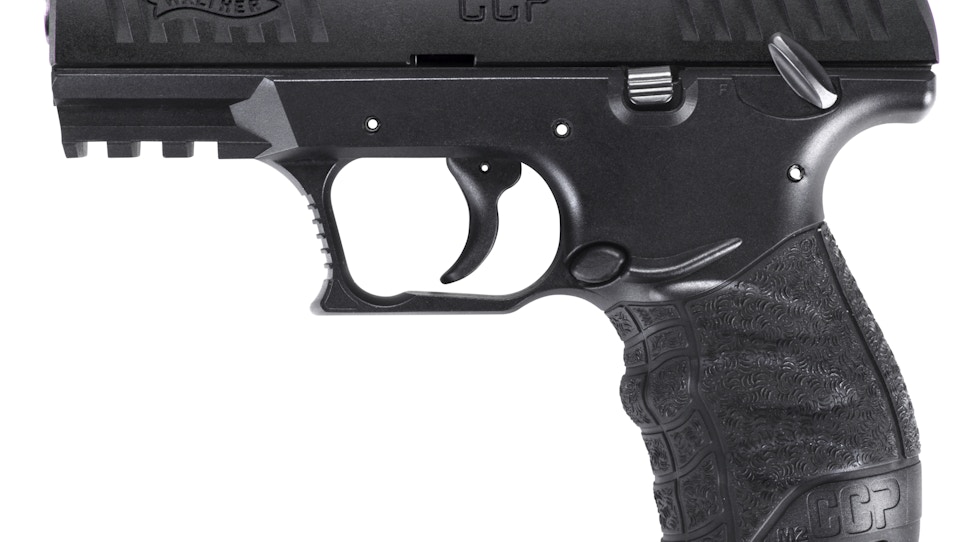
The Walther CCP M2 380 will deliver a super soft recoil thank to the proven Softcoil system from the 9mm verision. (Photo: Walther Arms)
Walther made a name for itself thanks to James Bond films and the still widely-popular PPK model line, but the new striker-fired polymer line has kept the Walther brand at the forefront of design, technology and features.
Walther is now just as well known for delivering cutting edge designs including the PPS, PPQ and CCP, which have become a benchmark feature and the quality standard for customers and industry competitors. For 2019, Walther will not disappoint fans and dealers with a number of new variants and models hitting the shelves.
Shooting Sports Retailer had an opportunity to talk with Cody Osborn, marketing manager for Walther US, about what’s next for Walther in 2019.
SSR: What is new for 2019?
Osborn: We are really excited about the newest addition to the PPQ family — the Q5 Match Steel Frame. Walther has taken the enormously popular Q5 Match polymer-framed pistol to the next level with the completely redesigned Match Steel Frame that delivers big advantages for competitive shooters. We have heard from our competitors that they really see an advantage to a steel frame, but want to retain the reliability and simplicity of a striker-fired gun.
SSR: What sets the Q5 Steel Frame apart in a sea of polymer pistols?
Osborn: There is still a reason top tier unlimited shooters still choose a steel-frame gun and that is due to the weight. Weight delivers a more stable and flatter shooting platform with a potentially tighter fit between the slide and frame, which can further improve accuracy. We listened to a lot of shooters who talk about how steel-framed Brownings, CZ’s and 1911s could settle down faster than their polymer pistols. We introduced the Q5 Match Steel Frame for these discriminating shooters, who want the best factory production match gun available. The weight allows the gun to not move around as much, and will really allow competitive shooters to get a lot of shots quickly downrange.
The overall profile is even more 3-D, which is an achievement considering this is not molded polymer, but CNC-milled steel. The Steel Frame will have a little different profile than the current poly-framed Q5 Match, but will still feel like Walther ergonomics. A heavier gun will tend not to bounce around as much as a polymer gun, and this 42.3-ounce beast certainly delivers the heft of a plus-sized 1911. The Steel Frame is our entry back into steel-frame guns, while still accepting the same super reliable magazines as the PPQ/M2 polymer series. The barrel and lock-up are different, but the slide, trigger and striker are all direct carryovers from the polymer Q5 Match, so fans of that gun will certainly love the new Steel Frame models.
We are starting by offering the Q5 Match Steel Frame with 9mm models, which will have recessed controls so thumbs forward are not going to interfere with operation. The Steel Match models will feature an aggressive extended beavertail, full-length picatinny dust cover, recessed-control slide release, 2-stage match trigger and fully adjustable rear and front hi-viz sights with threaded barrels available soon as an aftermarket part in the future. We will have two versions: the Standard and Pro models.
SSR: How will the two Steel Match models spec out?
Osborn: Both Q5 Match Steel Frame models will feature interchangeable grips and 20 TPI grip serrations on the front strap and carry through the features and controls of the Q5 Match line. The main difference will be that the Pro version will feature an extended competition magwell and +2 round magazine base pads to bring the capacity up to 17+1 rounds. We really want customers and dealers to know up front that these Steel Frame models will represent our premier line of handguns, starting with an MSRP of $1,499 and will be in very limited supply. Our target quality was to compete with the SVI 2011 and CV Shadow 2, but in a steel-framed striker-fired gun. We are confident these guns will be amazing in the competition circuit.
SSR: What other products can dealers and customers expect in 2019?
Osborn: The Q5 Match Steel Frame will steal the attention, but the CCP M2 line has a new addition as well. Since the introduction of the CCP line in 9mm we have had customers ask for a .380 version. The CCP M2 features our Softcoil Delayed gas blowback system that drastically reduces felt recoil. The newest CCP M2 model will be chambered in .380 ACP for an extremely pleasant shooting concealable defense handgun for those who are recoil sensitive or just do not want to get beat up during training and range time. The overall format, price and size will remain the same.
The CCP M2 really has been an incredible line for new and older shooters. New shooters like the softer recoil while still delivering full 9mm power, and seasoned shooters find they can be much more accurate without managing recoil in a small gun. The .380 version of the CCP will be a huge hit for a gun that is an easy, very soft shooting platform to train with in a very small compact carry format. Last but not least is that the PPK and PPK/S are coming back to Walther.
SSR: The legendary gun comes home?
Osborn: Yes. As most people will know the gun carried our moniker, but was made under a joint manufacturing agreement with Smith & Wesson. Production was stopped in 2012 and there have been no PPKs made since then. Any new PPKs since 2012 have been in essence new-old stock. With the new steel machining capabilities and exceptional quality that are apparent on the Q5 Match Steel Frame and our polymer slide designs, we really saw an opportunity to make the PPK legendary again with quality that exceeds the Interarms versions.
Walther will be making the PPK and PPK/S versions, with production planned to start in 2019. Germany will still make the slide in the Ohm plant, but every other part will be U.S.-made. We are going back to the original design with integrated sights, rounded edges and sight rib, and back to the beautiful quality that people expect when they pick up a PPK.
The PPK has been our most requested gun for the last four years and basically everything in the last six years was just overstock while we ramped up our facilities. We know the guns have been hard to come by, our dealers have been begging for them and of course prices in the used and new market have inflated.
The new Walther U.S.-produced gun will only be about $50 more from an MSRP perspective, but with the previously noted features and finish improvements. Over the years there have been some complaints that feeding and functioning issues could improve. Those will be addressed and worked out, with better ramps and chambers along with tighter manufacturing tolerances. This is a legendary gun for Walther and we want to take it to the original quality tier it was famous for.
SSR: What do you expect across the industry in 2019?
Osborn: For the new manufacturers, we are seeing a little panic that sales are not at the crazy level they once were. But for Walther it seems like we are through the craziness and are back to some stable, and most importantly predictable, growth. Our focus is really on delivering the new, seasoned collectors and professional shooters a line of guns they can be proud knowing they own — one of the best guns in the industry.






